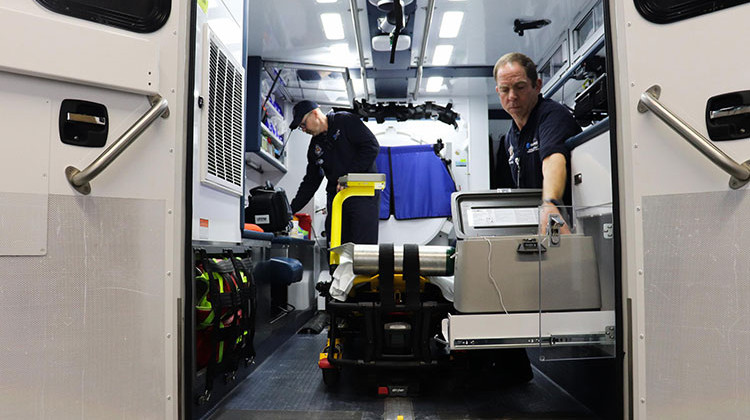
Paramedics Scott Widener (left) and Mike Warnimont (right) prepare the mobile stroke unit for the day.
Paige Pfleger/Side Effects Public Media
COLUMBUS, OHIO -- Paramedic Scott Widener crouches in the back of an outfitted ambulance.
“I am six foot and I’m duckin',” he says, laughing.
It’s first thing in the morning and his team in Columbus, Ohio is already hard at work checking equipment and preparing for the 12-hour day ahead.
“Drugs, pumps, IV tubing, different things we carry for if we do encounter a stroke patient,” he says, running a hand along the medical equipment. “So this is all truck checks, make sure everything is here, accounted for, in case we get a run.”
A run means someone in Columbus called 911 reporting stroke symptoms. A firetruck and a regular ambulance will show up, too, but that ambulance doesn’t have the expertise of Widener's team, which includes two specially trained paramedics, a nurse practitioner and a CT tech.
And that other ambulance doesn’t have the crowned jewel of the mobile stroke unit: a CT scanner.
“The scanner rolls out, then their head goes right in there, obviously,” Widener says.
The large donut-shaped scanner is the reason for the mobile stroke unit’s existence. It's one of only about 20 in the country, and 30 in the world. It can identify on the scene if someone is having a stroke, and if so, what kind.
There are two kinds of strokes: 15% are caused by a brain bleed, and 85% stem from a blood clot in the brain.
Doctor B.J. Hicks helps direct the stroke program at Ohio Health Riverside Methodist Hospital, and was instrumental in pushing for a mobile stroke unit here in Columbus. He says the distinction between the two types of stroke is important.
For clots, patients get a drug called IVTPA. But that medication cannot be given to patients that have brain bleeds.
“The nickname for TPA is 'clot buster,'” Hicks says. “So if you’re getting a clot-busting medication, that is a medicine that can potentially cause bleeding. So if you already have bleeding in the brain, giving TPA on top of that would be catastrophic.”

Jessica Sweigart is the CT Technologist on the stroke unit. (Paige Pfleger/Side Effects Public Media)
But at about $350,000, the CT scanner is too expensive to put in every ambulance. And while it exists in a typical hospital setting, Hicks explains the time it takes to get a patient to the hospital can be dangerous – even deadly.
“Unlike almost any other medical emergency, stroke is very time dependent,” Hicks says. “You lose up to 2 million neurons per minute when you have a significant stroke.”
Strokes are the leading cause of paralysis in the U.S., and the fifth leading cause of death. Every minute saved in delivering stroke treatment can add a day on to a person’s life.
The team is collecting data of their own, keeping track of patients for up to eight months after their stroke to compare those outcomes to people who didn’t use the unit. The unit has already treated more than 40 strokes in its first six months.
“Our hope is that in five or 10 years for now, there’s going to be mobile stroke units just like there’s EMS in all sorts of towns around the country,” Hicks says. “This is where we want to be in the future, and we’re extremely happy that Columbus is on the cutting edge.”
Technologist Jessica Sweigart locks the CT scanner into place for transport. “This keeps it stationary as the truck is moving,” she says.
The flashing lights turn on, illuminating a sign on the garage door: “You Got This.” And the ambulance rolls out onto the street.
This story was produced by Side Effects Public Media, a news collaborative covering public health.
 DONATE
DONATE








 Support WFYI. We can't do it without you.
Support WFYI. We can't do it without you.